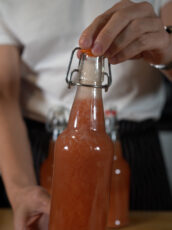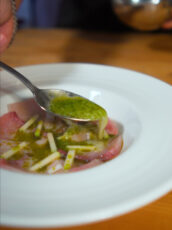If you’re looking for a refreshing, fizzy drink that’s naturally fermented and full of probiotics — water kefir might just become your new favorite.
Unlike milk kefir, which is made with dairy and has a creamy, tangy profile, water kefir is dairy-free, light, and often fruit-forward. It’s the perfect alternative for anyone looking to enjoy the gut-boosting benefits of fermented drinks without the heaviness of yogurt-based beverages.
Whether you’re into health drinks or just love making things from scratch, this post will walk you through how to make water kefir, how to flavor it, and why Raspberry-Guava is one of my favorite combos.
🌱 What Is Water Kefir (Tibicos)?
Water kefir is made using tibicos, also known as water kefir grains. Despite the name, these “grains” aren’t made of wheat, rice, or any other cereal — they’re actually a type of SCOBY, which stands for Symbiotic Culture of Bacteria and Yeast.
🔬 What is a SCOBY?

A SCOBY is a living microbial community where different species of bacteria and yeast coexist in a stable, gelatinous matrix. In the case of water kefir grains, this matrix forms in crystal-like clusters that range from translucent to slightly amber, depending on what sugars and minerals they’re exposed to.
When you add a SCOBY to a sweet liquid, the yeast in the grains consume sugars and produce alcohol and carbon dioxide. Then, the bacteria convert the alcohol into organic acids, like lactic acid and acetic acid. This is what gives water kefir its signature mildly tangy, lightly effervescent character — it’s not as sour as kombucha or as sharp as vinegar, but still bright and lively.
The balance of sugar, alcohol, acid, and CO₂ is what creates the slightly sweet, slightly tart, and naturally carbonated taste of well-made water kefir.
Because it’s so adaptable, water kefir can be brewed with sugar water, coconut water, or fruit juices — each one slightly altering the flavor profile and fermentation speed.
🥛 Water Kefir vs. Milk Kefir: What’s the Difference?
| Water Kefir | Milk Kefir |
| Dairy-free | Made with dairy milk |
| Light and fruity | Creamy and tangy |
| Uses tibicos (water kefir grains) | Uses milk kefir grains |
| Fermented in sugar water or juice | Fermented in milk |
| Vegan-friendly | Not suitable for dairy-free diets |
Water kefir is an easy entry point for anyone new to fermentation — it’s forgiving, flexible, and endlessly customizable with flavors.
📦 Where to Get Water Kefir Grains + How to Store Them
You’ll need live water kefir grains (tibicos) to get started. They’re often sold through:
- Facebook Marketplace (where I found mine!)
- Local fermentation groups
- Online retailers or health food shops
🌸 Flavoring Ideas for Water Kefir
My go-to flavorings:
- Fresh fruits: Raspberries, blueberries, mango, passionfruit
- Dried flowers and herbs: Hibiscus, rosella, lemongrass, lime leaf
- Spices: Ginger, cinnamon, cloves (use lightly)
⚠️ Watch the acidity: While citrus juices like lime or lemon can taste great, they can inhibit fermentation if used in high amounts. I recommend using them as post-fermentation flavorings or in moderation during the second ferment.
What to do with excess grains:
Water kefir grains tend to multiply rapidly with each batch. If you find yourself with too many, you have a few good options:
- Give them away to friends, neighbors, or local fermentation groups.
- Start a second batch if you want more kefir on hand.
- Compost or discard them if you’re truly overrun — they’re organic and biodegradable.
How to store water kefir grains:
- Short-term (1–2 weeks): Keep them in sugar water in the fridge.
- Long-term (1+ months): Dehydrate them or freeze with a bit of sugar.
Just remember — they’re alive! So feed them occasionally and keep them clean.
✨ How Water Kefir Fermentation Works
- Sugar Breakdown (Yeast) — Yeasts consume sugars from the sweet liquid (glucose/sucrose).
- Alcohol Production — Yeasts convert sugars into ethanol and CO₂ (carbonation).
- Acid Formation (Bacteria) — Bacteria convert the alcohol into lactic and acetic acids.
How to Make a Raspberry-Guava Water Kefir (My Favorite Flavor)
This is one of my absolute favorite ways to enjoy water kefir — it’s floral, slightly tropical, and packed with berry brightness. Here’s how to make it:
🛒 Ingredients:
- 2 L water
- 60 g granulated sugar
- 60 g coconut sugar
- ½ cup water kefir grains
- ½ cup raspberries (fresh or frozen)
- ~1 L guava juice
🥄 Instructions:
1. Make your sugar base:
Combine water, granulated sugar, and coconut sugar in a large jar. Stir until fully dissolved.
2. Add the tibicos and fruit:
Add in the water kefir grains and raspberries.

3. Cover and ferment:
Cover loosely with a lid or cloth. You want air exchange — not a sealed container — to prevent pressure buildup. Let it sit at room temperature for 48 hours, tasting every 24 hours. It will get less sweet and more tangy over time.
4. Strain and bottle:
Once it tastes pleasantly tart and lightly yeasty, strain out the raspberries and kefir grains.

5. Bottle and flavor:
Fill bottles about ⅔ of the way with the fermented kefir. Top up with guava juice, seal, and let sit at room temperature for 12–24 hours for a second fermentation. This is where the bubbles really develop.

6. De-gas and chill:
Open the bottles slowly to release built-up pressure. It can get very carbonated, so do it over a sink. Store in the fridge and enjoy chilled.
✅ Storage Tip: Once refrigerated, water kefir can last weeks to months and will continue to develop flavor over time (it will become less sweet and more acidic over time!).
✨ Final Thoughts
Water kefir is one of the most approachable, rewarding fermented drinks you can make at home. It’s refreshing, full of gut-friendly probiotics, and endlessly customizable. Whether you’re into florals like hibiscus or fruit-forward blends like Raspberry-Guava, you’ll never run out of flavor possibilities.
Once you’ve got your grains, all you need is sugar, fruit, and time.








